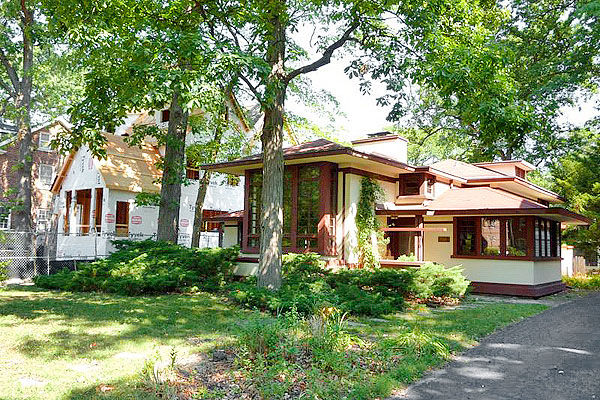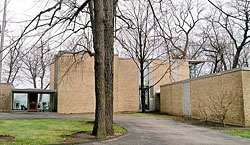
UPDATE: We have edited this post to include quotes from George Hausen.
Two historical North Shore homes, both on the market, were built according to very different aesthetics and are at price points far removed from one another. But they do have one thing in common: despite the eagerness of preservationists to see the houses saved, they both face the threat of being demolished.
The older of the two houses is a woodsy cottage in Wilmette that is linked to three innovative architects: Frank Lloyd Wright, Rudolph Schindler, and John Van Bergen. George Hausen, the developer who paid $800,000 for it and a companion building next door (which was moved off the lot by a buyer), has the house listed for $599,000.
According to Lisa DiChiera, director of advocacy for Landmarks Illinois, Hausen told her in the spring that he would give the house about four months on the market, and if it didn’t sell, he would demolish it and start building a new home on the site. (Construction is already under way on the other portion of the site, as you can see in the photo.) DiChiera believes time runs out at the end of August. The agent on the house, Merry Juell, did not return calls about the property.
In February Hausen told WBEZ’s Lee Bey, “If nobody wants the cottage, it will be demo’d.” But he may have had a slight change of heart. Hausen told me yesterday that if there were no sale by late August, he “could give [the house] a little more time, probably.”
Still, things don’t look promising. “We’ve had north of 75 showings, and there’s no interest in buying,” Hausen said. “The comment keeps coming back that the house is too dated and too small to renovate.”

Meanwhile, the sellers of a larger and somewhat more austere home on 27 acres in Lake Bluff have not set a time limit. But DiChiera and others worry that, because of the house’s looks and the allure of its woods-and-ravine lot—and the fact that the home is not protected by any landmarks ordinances—the property will go to a high-end buyer who would knock the house down to make way for a new one.
Designed by the mid-century masters Keck & Keck in 1955 for the investment banker Edward McCormick Blair, this house has severe brick walls and a boxy form. Houses in this style “are more beautiful on the inside,’ DiChiera says. Only one interior photo accompanies the listing (I was not allowed to visit the house), but that photo suggests a serene pavilion.
Blair died in the home in late 2010; it has been for sale by his estate since early 2011, with an asking price of $9.995 million that has held firm. The listing agent, Marina Vernon, declined to comment for this article.
The pool of potential buyers with $10 million is mighty small in Chicago; we’ve had three $6-million condo sales in the past two weeks, but nothing has sold in the $10 million range in a few years. From among those few well-funded buyers, “you have to find the one who’s a lover of mid-century architecture,” DiChiera says. Her organization had the house on its list of the top 10 endangered Illinois buildings last spring.
Each house is an artifact of its era—one from the hand-crafted aesthetic of the Prairie School, the other from the “machine for living” years following World War II—but DiChiera does see a commonality. Both have double-height living room windows that frame views of the surroundings. “They’re both embracing the natural landscape around them,” she says—though the Wilmette house attempts to feel like part of nature, and the Lake Bluff one emphasizes how it’s different from nature.
With the clock running down in Wilmette and Lake Bluff after nearly a year and a half, the question now is, Does today’s real-estate market put any value in either one? Sadly, it looks as if the answer might be no.
Photograph: (Lake Bluff house) Susan Benjamin, Benjamin Historic Certification


